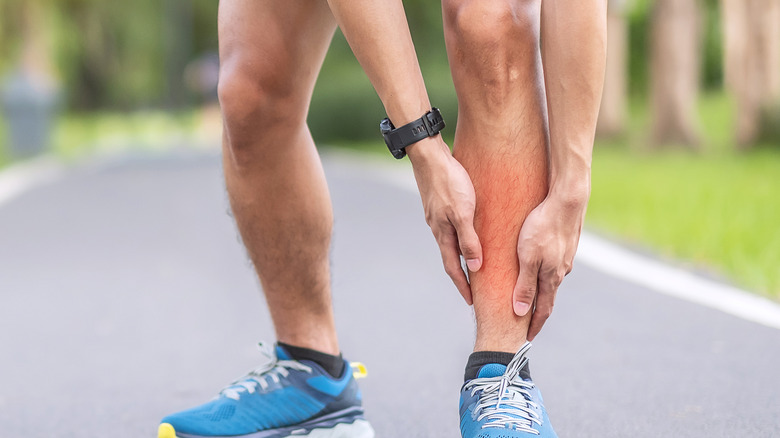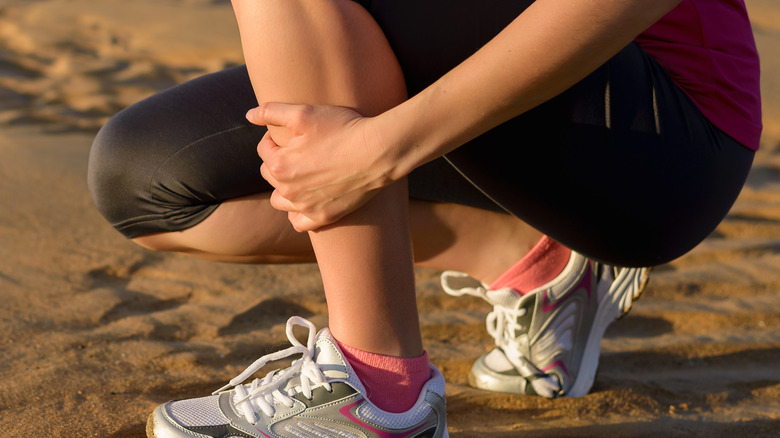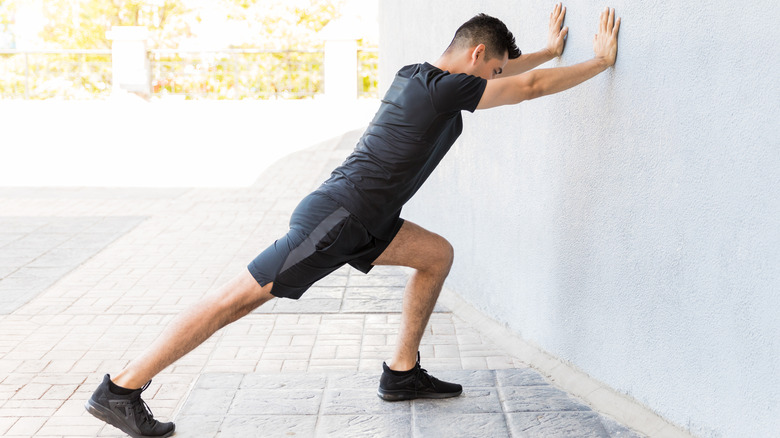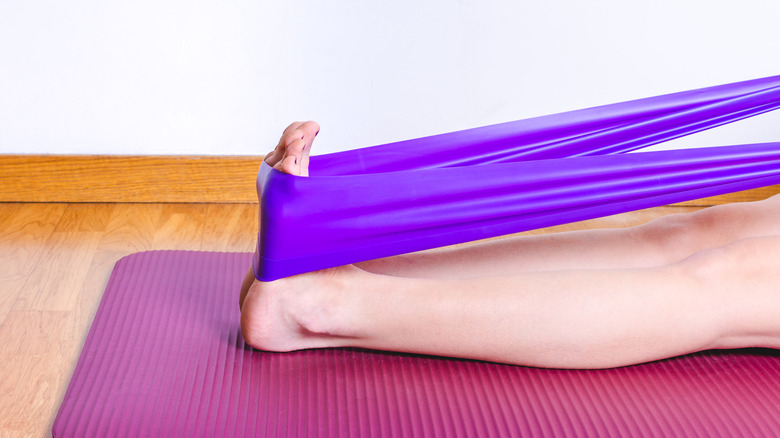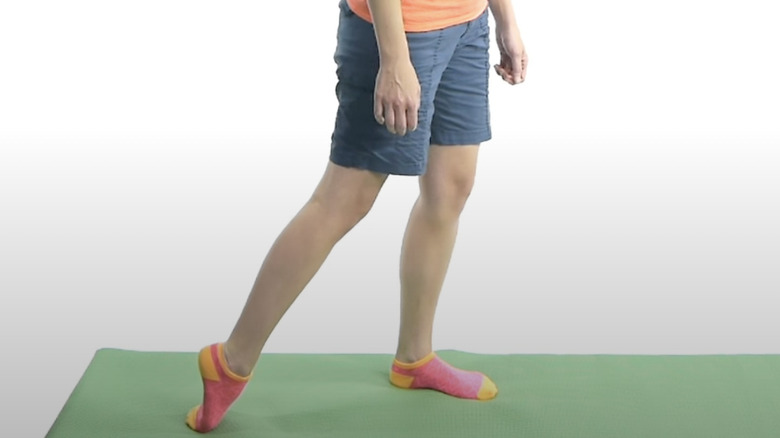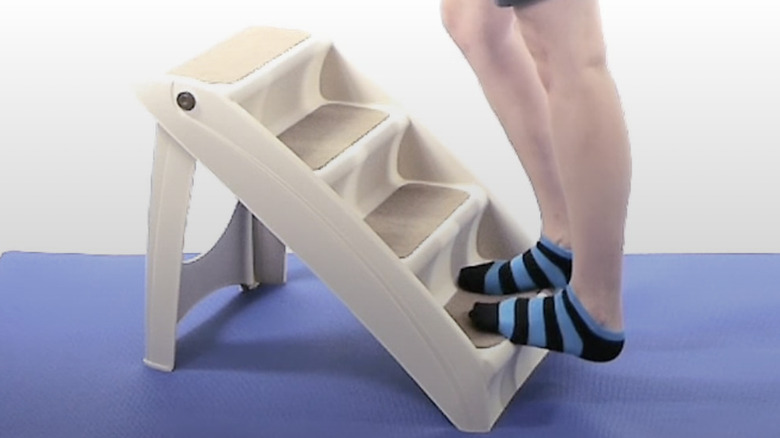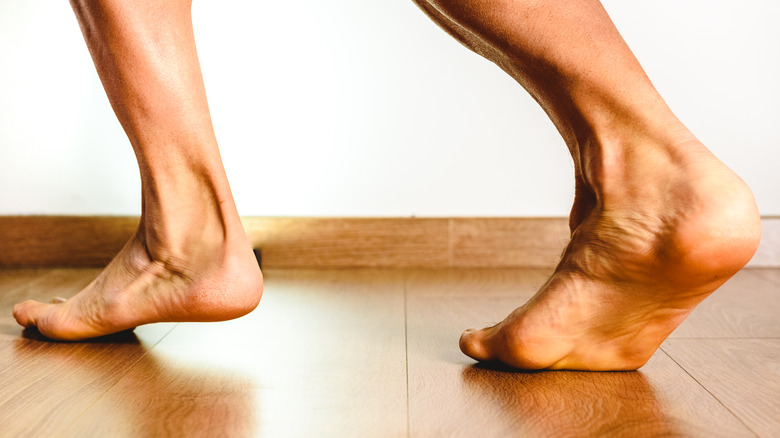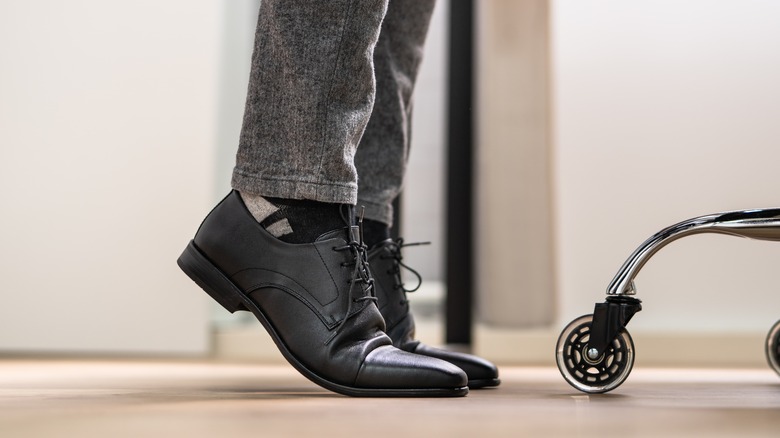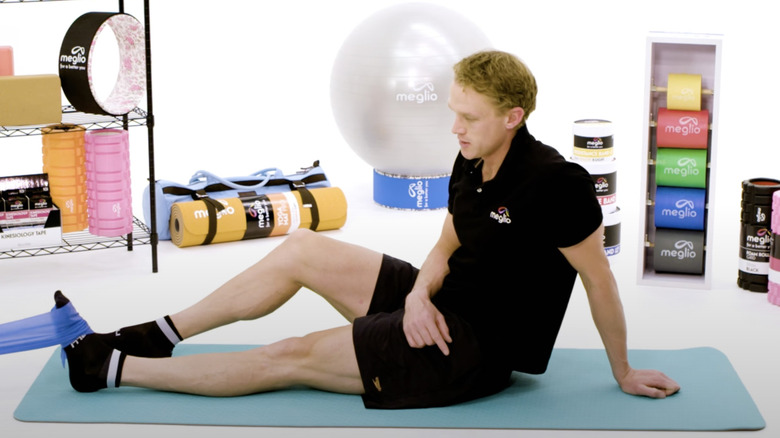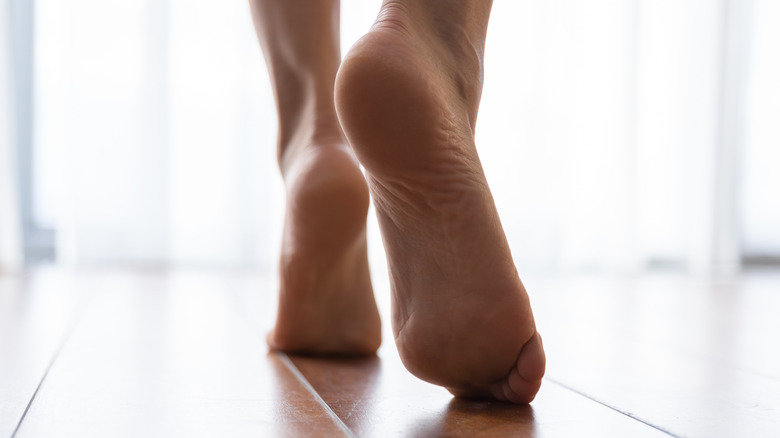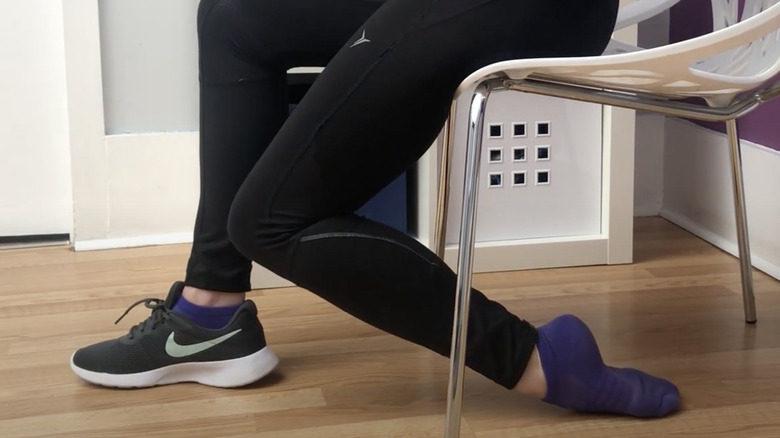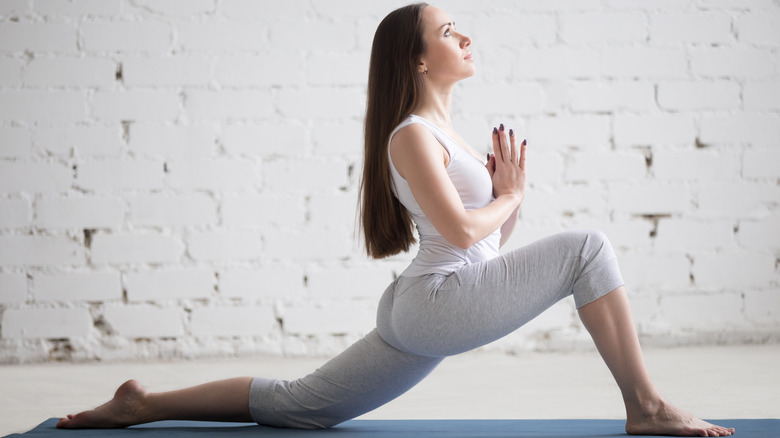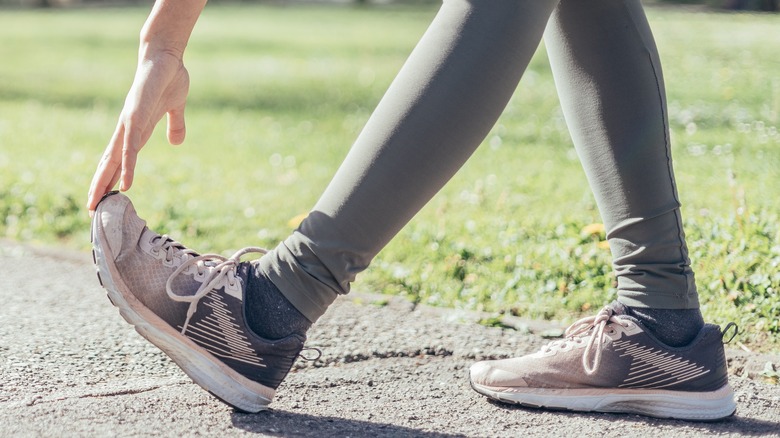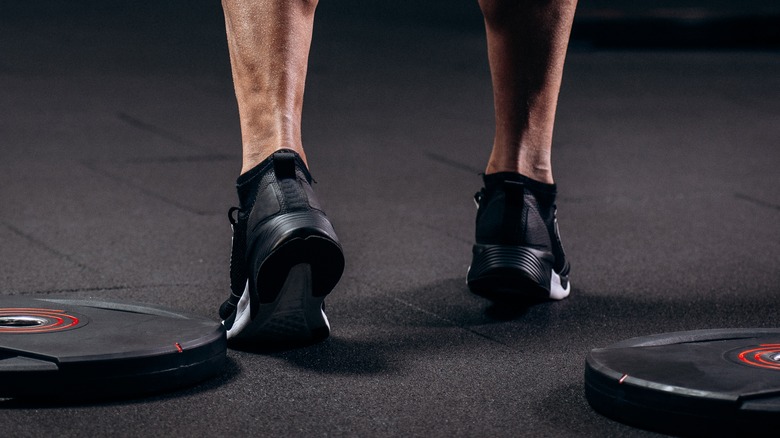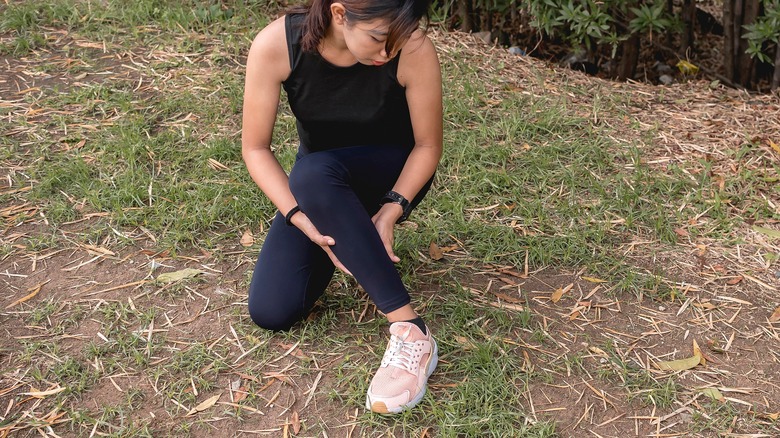The Best Exercises To Help Relieve Shin Splint Pain
Picture the scene: You head out on a gloriously sunny Saturday morning for a jog. It's been a busy week, full of phone calls and Zoom meetings, but this time in nature is yours. As the trees rush by you and the air fills your lungs, suddenly you take a step and ... Bam. A shooting pain flies up your shin, and it doesn't let up.
This is a familiar scenario for folks worldwide in terms of how they got their very first shin splint. Shin splints are characterized by a sharp, shooting pain around your tibia (also known as your shin bone), per Medical News Today. A huge number of people experience them each year; in fact, approximately 17% of all women who are injured when running recreationally have to deal with them, according to a study published in the Journal of Orthopaedic & Sports Physical Therapy. And it's not just joggers who have to deal with shin splints, with the condition (also known as medial tibial stress syndrome) rearing its head as an injury when doing other exercises like dancing.
But when shin splints strike, how do we deal with them? Well, we've got you covered. Let's take a look at the best exercises you can do to relieve your aching shins (or stop them from aching in the first place).
Why do shin splints happen?
Although you might assume that shin splints might indicate a broken bone thanks to the sharp and sudden pain, they're actually caused by inflammation (per MedlinePlus). Normally, your shins can bear your weight and the day-to-day impacts your movements bring, but when you're exercising too much or adding additional high-impact moves to your workout, your leg muscles can become overloaded. When this happens, the tissues around your shin bone can become inflamed, creating the aches that runners know so well.
Your likelihood of shin splints can be exacerbated by exercising on hard surfaces like concrete or asphalt, where the impact can be more, well, impactful on your shins. And if you have flat feet or inflexible arches, you may develop shin splints more frequently. The good news, though, is that you don't have to just put up with them. By performing strengthening exercises and simple stretches (which is exercise in and of itself, helping to improve flexibility and range of motion, as NBC News discusses), you can seriously quell the pain that shin splints deliver and heal them faster.
Soleus calf stretch
We typically think of the calf muscle as one big block of muscle tissue, but did you know that it's actually made up of two different muscles? Your larger, gastrocnemius muscle is supported by the smaller soleus muscle, fitting snugly beside it and running down the length of your lower leg, as South Florida Sports Medicine discusses. The soleus muscle is also connected to your tibia (or shin bones), and when there's an injury to the muscle — often from absorbing the shock of the foot landing on the floor — shin splints can flare up.
Fortunately, there's hope on the horizon. A simple soleus calf stretch can assist in bringing flexibility to the muscle and reducing shin splint pain caused by impact. Stand a few steps back from a wall, facing it, and step forward with your uninjured leg, advise the experts at G4 Physiotherapy and Fitness. Coming into a lunging position, place your hands on the wall in front of you and gradually lean forward, until you feel a stretch going through your back leg. Hold this stretch for up to 30 seconds, repeating several times, and make sure that you repeat the stretch on the other side, regardless of whether you have a shin splint in that leg or not.
Seated calf stretch with resistance band
Our calves go through a lot. Every time we move anywhere on our feet, our calves are helping to generate movement and keep us upright — but a lot of the time, we end up neglecting these essential muscles. "People tend to forget to stretch smaller muscles that are further away from the trunk of their body," states NEOU Fitness instructor and certified personal trainer Sarah Otey (via SELF). And when your calves become tight and inflexible, be that through lack of movement, improper footwear, or overuse, this can result in shin splints.
That's why stretching out your calves is so important, and a seated calf stretch with a resistance band is a great place to start. It's, an especially awesome move if you have limited motion already, says Otey. Sit on your butt on the floor, and extend your legs so that they're flat in front of you. Then, grab your resistance band and place it around the bottom of the foot that has the tight calf. Using both hands to grip either side, pull the band towards you, until your calf gets a good stretch. Make sure you stretch your other leg, too.
Tibialis anterior stretch
If you're experiencing shin splints, there's a good chance that it could be because of your tibialis anterior muscle. Running down the length of the front of your leg, your tibialis anterior muscle is involved in flexing your foot, and helps to keep your leg and ankle stable as it impacts the ground (via Kenhub).
Luckily, it's easy to stretch the muscle out and keep it from becoming tight, using a tibialis anterior stretch (or toe-drag stretch). Start in a standing position, with a slight bend in your knees, as Piedmont Orthopaedics shows. Take the foot which has the tight tibialis anterior muscle, move it back slightly, and then lift your foot off the ground and place the front of your foot down. The upside of your toes should be pressing into the floor. Then, gently apply pressure to the back foot, so that you feel a stretch through the front of your lower leg, holding this position for 15-30 seconds. Release your foot from the ground, and then repeat with the other foot. Perform the stretch multiple times if necessary.
Standing Achilles tendon stretch
The Achilles tendon is pretty impressive, huh? Aside from having a very cool, mythology-inspired name, it helps the foot function in pretty much every movement it does every single day. But when your Achilles tendon isn't as strong — whether because of a new exercise or alterations to your existing workout program — other muscles can step in and compensate, as Podiatry Today says. This imbalance may then create shin splints.
The best solution to this is to keep your Achilles tendon strong and supple and to stretch it regularly. All you'll need is something to stand on that'll elevate you slightly, like a stair step or a thick book, per Healthline. Step onto the elevated surface, and let one of your heels hang off the edge, with the ball of your foot still on the step (it's best to not pick something too high for these purposes, and to have something to hold onto to keep your balance, like a rail). Then, gradually let the heel of the hanging leg drop slightly, so that you achieve a stretch in the Achilles heel, holding that stretch for around 30 seconds or so. Repeat with the other foot, and perform the stretch several times a day.
Gastrocnemius stretch
Your calf is made up of two main muscles, and the gastrocnemius sits snugly alongside your soleus to create that melon-ball calf effect that's so desired by bodybuilders (per Sports Medicine Australia). Unfortunately, though, a strain or injury to your gastrocnemius muscle can create problems — and when this happens, shin splints can take place, too.
To combat this and relieve pain, try giving the gastrocnemius stretch a go. Begin by standing facing a sturdy wall, and then lean forward slightly and place your hands on it, as Saint Luke's demonstrates. Take a step forward with one of your feet, and bend the knee slightly, so that you're learning forward. As you lean forward, the calf muscles (including the gastrocnemius) in your back leg should start to stretch out. For the best results, you need to hold this stretch for slightly longer than you might think (approximately 30-60 seconds). Release the stretch after this amount of time, and then repeat the stretch. Then, do the same on the other side.
Calf raises
It's worth remembering that just stretching out your muscles won't necessarily be the best way to relieve shin splint pain. For best results, you also have to make your muscles stronger, as Medical News Today says. This is especially the case with your calf muscles, which take a huge amount of impact every time you take a step, particularly when you're performing high-impact activities. And that's where calf raises come in.
Begin by standing up straight, with your legs hip-width apart, either on a flat surface or on something slightly raised, like the bottom tread of a staircase. Then, gradually raise onto your toes, feeling the activation through the calf as you do so. When you get to the top of your range of movement, pause and hold the position there for around 20 seconds or so. Then slowly allow your feet to return to the first position. If you're standing on an elevated surface, you should get a larger range of motion, as when your feet come back down, they'll go slightly further, giving you more activation through your calf muscles. Repeat as many times as desired before resting, for a full set.
Anterior tibialis strengthening exercise
Shin splints are often caused by an overloaded muscle becoming inflamed, and this can frequently occur because we've worked them too hard. But strengthening our muscles can reduce not only the risk of injury occurring, but also the risk of injury happening again in the future. Muscle strengthening exercises can correct imbalances in our lower leg muscles and help us train with better efficacy and form, again lowering the chances of becoming injured through improper use (per OSR Physical Therapy).
Targeting and strengthening your anterior tibialis muscle is a fantastic way to tend to the muscles around your shins. Begin in a sitting position, and place an exercise band over the top of your foot (via Healthline). Then, loop the other end of the band around something which won't move, like a heavy table leg or fixture. Gently flex your foot towards you, feeling the activation through the front of your lower leg, and hold briefly at the top. Slowly lower your foot back to your starting position, and repeat up to 20 times per set.
Toe and heel walking
Remember when you were a kid, when walking on your tiptoes seemed like the most fun thing in the world? (Look, we had quiet childhoods, okay?) Well now you can do the same as an adult — and the great news is, it'll help you prevent shin splints. Both walking on your toes and walking on your heels will assist in strengthening the lower leg muscles, thereby aiding to prevent injury (per Nike).
So, how do you do toe and heel walking? It's kinda what it says on the tin, folks! With your feet hip-width apart, move up onto your toes, and then walk for roughly 20 meters or so before resting, repeating for around five sets (per Yorkville Sports Medicine Clinic). Alternatively, do the same thing, but using just your heels, ensuring that your toes are lifted from the ground as much as you can without losing balance. Alternating toe and heel walks will train different muscles in the lower leg and ensure that you're strengthening from both sides. Naturally, though, you'll want to do this in an area with no significant risk if you lose balance.
Seated shin stretch
Honestly, we think shins get a bad rep. Something that's known primarily for how painful it is when you bash it isn't exactly going to be a fan favorite, we get that. However, tending to your shins will not only extend a little bit of love to an under-appreciated body part, but also allow you to get a little relief from any shin splint pain you're experiencing. A seated shin stretch can do just that — and the best part is, you can do it when you're sitting at your desk or your dinner table (via Piedmont Orthopedics).
Placing your butt in a chair, allow your injured leg to curl under your chair, and then place your toes on the ground top-side up. Slightly scoot yourself forward in your chair, or lean your body forward slightly, until you feel a stretch through the front of your lower leg. Keep the stretch held for up to 30 seconds, and then rest. Then, repeat on the other side, to avoid any imbalance.
Low lunge ankle stretch
While we might assume (and sometimes rightly so) that shin splints are caused by a problem with, well, your shin, the reality can be far more complicated than that. Shin splints can be generated by any part of your lower leg, and your ankle can be one of them. This can be especially common when your ankle is tight, with the lack of mobility then potentially increasing the risk of injury (per Go Beyond Physical Therapy).
A low lunge ankle stretch, though, can encourage flexibility in your ankle joint. To begin, you'll need to move into a low lunge position, with your back knee flat on the floor and your hands placed by either side of your front foot, as Active shows, or in a prayer position at your chest. Make sure that your back foot is flat on the ground (with the top of your foot connecting fully with the floor), and then gradually shift your body weight forward, so that you start to get a stretch through the back ankle and lower leg. Breathe into the stretch, and hold the position for about a minute or so. Then, shift your body weight back to release the stretch, change your legs, and repeat on the other side.
Standing bent-over calf stretch
Your calves and your shins are two sides of the same coin, and taking care of both of them will allow you to keep shin splint pain at bay. But it's worth remembering, too, that keeping your calves loose and supple will help you avoid a range of injuries.
"Achilles tendonitis, shin splints, knee pain, plantar fasciitis...these can all originate from tight calf muscles," says California State University department of kinesiology chair Jan Schroeder (via SELF). When your muscles are short and tight, they tug at other parts of your leg, thereby creating injuries elsewhere.
A standing bent-over calf stretch, however, will introduce more flexibility into your calves, while also giving your hamstrings a good stretch. Begin in a standing position, with one foot slightly in front of the other. Bend your back knee a little and keep your front leg straight. Then, bend forward, towards your straightened leg, and grab its toes (if you can't reach down that far, go as far as you can go — remember, it's not a competition, folks!). Pull your toes towards you slightly, and hold the stretch for as long as is comfortable, before repeating with the other leg.
Gastro-soleus strengthening exercise
Your gastrocnemius and soleus muscles are like two peas in a pod, making up your calf muscles and that telltale bulge. Cute, right? Just a pair of friends, hanging out, helping you do every movement under the sun. But weakness in the gastro-soleus muscles can be a key cause of shin splints, which is why it's useful to train them both together with this easy exercise.
Stand with your feet a regular width apart, and then gradually raise your body onto its toes on a count of two, as Healthline states. Hold at the top, and then lower your body on a count of four, for a single rep. Repeat for up to 20 reps, for around three sets every day.
If that's not challenging enough, you can try to perform the gastro-soleus strengthening exercise using just one leg at a time, which will add further body weight and balance challenges. You can also shift the positioning of your feet, putting them on an inward or outward angle to hit the muscles from a different perspective. If you wanted to really test yourself, you could also perform the movement using dumbbells. The world's your oyster with this simple exercise!
What other measures can I take to prevent shin splints?
While stretching out and conditioning your lower leg muscles is one of the best lines of defense to treat and prevent shin splints, it's worth knowing that it's not the only way to do so. As shin splints are commonly caused by overuse and impact, adjusting your footwear to introduce arch supports and insoles that are designed to lessen shock can be an effective move (per the Mayo Clinic). It's also useful to ensure that your shoes aren't becoming too worn out — you should aim to replace your trainers every 350-500 miles you run, which is roughly equivalent to 113 5-kilometer runs at the minimum.
You may also want to consider the surface you're running on (with hard surfaces more likely to create lower leg and shin problems) and vary your exercise so you're not just doing high-impact activities. If you're finding that shin splints are a frequent occurrence, it could be worth speaking to a physiotherapist. They should be able to identify if your running or exercise style is creating an imbalance or additional impact and contributing to lower leg injuries.
Above all, though, remember not to overdo it on the exercise: If you're experiencing lower leg pain, stop and rest until you're fully recovered.

